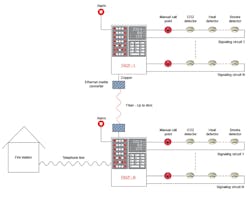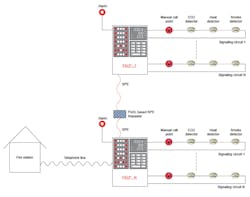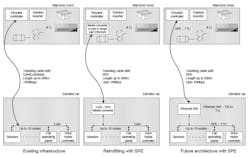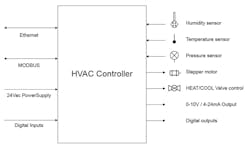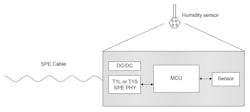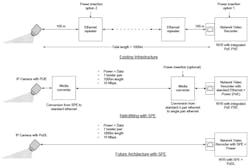Download this article in PDF format.
Ethernet has become a mainstream communications protocol and sits atop the control pyramid in building automation. Recently, the Institute of Electrical and Electronics Engineers (IEEE) defined an Ethernet standard, IEEE 802.3.cg, for 10 Mb/s operation and associated power delivery over a single balanced pair of conductors. Because a single-pair cable can now support both data and power, adoption of the standard can lead to significant cost savings and easier installation in building automation applications.
There are numerous efforts to take Ethernet to edge devices. Multiple communication networks currently exist in building automation—for example, heating, ventilation, and air-conditioning (HVAC) applications use Modbus; access control uses BACnet; lighting uses LonWorks; and fire safety uses Ethernet. This fragmentation of networks requires gateways to perform protocol conversion to unite networks at the top of the building automation control pyramid. End users must in turn manage complex systems.
Reasons for the existence of various communication networks include the need for longer distances, multidrop connectivity, powering scheme, and support for unique protocols. Single-pair Ethernet can address many of these reasons. Having Ethernet to the edge devices offers benefits such as direct accessibility for the control system, status updates, predictive maintenance, standardized hardware, and interoperability across various systems.
Overview of SPE
Standard Ethernet uses simplex communication with independent cables for transmitting and receiving data (Fig. 1).
Single-pair Ethernet (SPE) is broadly classified into three categories:
- IEEE 802.3.cg (10 Mb/s)
- IEEE 802.3.bw (100 Mb/s)
- IEEE 802.3.bp (1,000 Mb/s)
IEEE 802.3cg has two more classifications:
- Long and short cable lengths reach over a single balanced pair of either shielded or unshielded wire. 10BASE-T1L: IEEE 802.3 Physical Layer specification for a 10-Mb/s Ethernet local-area network over a single balanced pair of conductors up to at least 1,000-m reach (long reach using 18 AWG wire for point to point connection.)
- 10BASE-T1S: IEEE 802.3 Physical Layer specification for a 10-Mb/s Ethernet local-area network over a single balanced pair of conductors up to at least 15-m reach (short reach using 24-26 AWG wire with multidrop connection.)
This article covers use cases for 10BASE-T1L, which offers up to a 10-Mb/s data rate over 1,000-m distances in building automation systems.
The 10BASE-T1L physical layer (PHY) operates using full-duplex communications over a single balanced pair of conductors with an effective data rate of 10 Mb/s simultaneously in each direction. The 10BASE-T1L PHY uses three-level pulse amplitude modulation (PAM3), transmitted at 7.5 megabaud on the link segment. A 33-bit scrambler can help improve electromagnetic compatibility.
MII transmit data (TXD<3:0>) are encoded together using four-binary three-ternary (4B3T) encoding, which keeps the running average (dc baseline) of the transmitted PAM3 symbols within bounds. Using the management data input/output interface to set the transmitter output voltage of the 10BASE-T1L PHY to 1.0 V p-p or 2.4 V p-p differentials will help achieve a longer communication distance over different cables.
SPE uses echo cancellation to achieve full duplex communication, along with multilevel signaling and equalization to improve signal quality and achieve the required data rate over a single-pair cable (Fig. 2). There’s no difference in the interface between the processor and the PHY; however, within the PHY, the transmit and receive sections of the Medium Dependent Interface require modification as outlined above to enable single-pair operation.
SPE also enables sending power over data lines (PoDL) along the same single-pair cable through a low-pass filter like the one shown in Figure 3.
The table lists the various power classes supported by the IEEE 802.3.cg standard. The maximum power deliverable to the load is 52 W and is defined under Class 15. Power classes below 10 are covered by IEEE 802.3.bu.
Benefits of SPE
Transitioning to SPE has multiple benefits, starting from installation to managing an entire building using a single communication network. Its benefits result in a lower total cost of ownership and a better return on investment in building automation systems. For example:
- Having Ethernet connectivity brought to the edge eliminates the need for additional gateways, which simplifies systems by only requiring a single communication network.
- PoDL eliminates the need for a separate power cable, which simplifies wiring in building automation systems.
- With just one pair of wires, the cabling becomes cheaper and lighter, making overhead wiring easier.
- Faster and easier installation reduces the cost of labor.
- Improved bandwidth compared to existing fieldbus networks provides the flexibility to implement features such as predictive maintenance.
- 10BASE-T1L offering communication distance of 1,000 meters at a 10-Mb/s data rate helps replace costlier fiber cables and enable more data transfer.
The following section explains how SPE can be implemented and the associated benefits for various building automation applications.
Fire Safety Applications
Fire alarm control panels (FACPs) connect to various heat, smoke, and gas detectors. These sensors, connected together in the signaling loop, generate an alarm in case of accidents, and FACPs may communicate to fire stations through a telephone network. An FACP often supports multiple signal loops to facilitate splitting into various zones or floors for easy identification.
Each building can have multiple FACPs, depending on the number of floors and sensors. When a facility like a large residential complex, office, school, or shopping mall expands, there’s often a need to interconnect FACPs across buildings as far as 3 to 4 km apart through Ethernet, using either copper or fiber wires.
Ethernet based on 100BASE-TX/10BASE-T) require multiple repeaters to bridge such distances; as a result, powering them can be a challenge. Another option is to transition to fiber cables, which require media converters (copper to fiber) at both ends. Figure 4 depicts an example system.
Both of the options described above result in expensive systems. SPE can solve both challenges for distances up to 1 km. For systems with greater distances, you can use repeaters powered through PoDL. PoDL eliminates the need for an external power supply, further simplifying the system. Figure 5 depicts a fire safety system using SPE.
Vertical Transportation Applications
Elevators are a complex system. The main communication link between a moving elevator car and the machine-room controller is through a traveling cable. The length of this cable can be anywhere from 10 to 500 m or longer, depending on the height of the building. Controller area network (CAN) and LonWorks are common protocols used for elevator systems, given their low-speed requirements and required cable distances.
Cable reliability over a period of several years is important due to the amount of stress it experiences during operation. As the elevator moves up and down, the cable needs to bend, which isn’t ideal for optical fiber cabling. Therefore, most elevator cables are made of copper. And given the cable length, standard Ethernet isn’t suitable because it can’t work beyond 100 m.
Now, with SPE offering 1-km distances and speeds up to 10 Mb/s, it’s a good choice for next-generation elevator designs. The need for higher data rates between the elevator car and elevator controller arises from:
- Streaming video content from inside elevator cars back to the machine room.
- Relay of advertisements from machine room to elevator car.
- Sending more data to the elevator controller from various sensors, along with data from equipment within the car to be used for predictive maintenance.
One example of predictive maintenance is monitoring the movement of an elevator door’s opening and closing by measuring the door’s motor current during its acceleration, steady-state, and deceleration periods, and analyzing any abnormality. The ability to predict potential failures would avoid elevator downtime and passenger inconvenience.
Upgrading existing elevators is equally as important as designing new elevators with more advanced features. One way to resolve retrofitting challenges is to have media converters like CAN to SPE inside the elevator car and SPE to standard Ethernet or CAN for the elevator controller (Fig. 6).
For next-generation systems, the elevator controller could incorporate a built-in SPE PHY 10BASE-T1L and the equipment within the car would be connected through SPE PHY 10BASE-T1S. The elevator car would also have a built-in 10BASE-T1S-10BASE-T1L Ethernet switch to interface the car with the elevator controller. Emergency lights and communication systems within the elevator car could be powered through PoDL to ensure that there’s no disruption of power.
HVAC Applications
HVAC controllers are being unified in order to control a rooftop unit, chiller control unit, air-handling unit, and more. HVAC controllers use standard Ethernet to interface with higher-level building automation systems such as the building management system, as well as to daisy-chain multiple HVAC controllers. To maintain network connectivity when powering off any of the HVAC controllers, electromechanical relays short the Ethernet signals at the input and output ports.
HVAC controllers have multiple analog, digital, or fieldbus interfaces to communicate or control multiple sensors that measure parameters like temperature, humidity, and pressure (Fig. 7). The sensors could be analog output with loop power, or support 0- to 10-W/4- to 20-mA output with separate power. HVAC controllers can also connect to actuators like dampers, fans, and stepper-motor drives through communication interfaces or analog connections. Having SPE connectivity from the controller to the sensors and actuators would simplify installation with only two wires and enable access to devices at the edge.
Figure 8 illustrates one example implementation using a humidity sensor, where the I2C interface connects to a microcontroller (MCU) with built-in media access control (MAC). SPE PHY (10BASE-T1L or 10BASE-T1S) interfaces to the built-in MAC of the MCU, while PoDL with a dc-dc converter powers the entire circuit. This architecture offers multiple benefits, including standardization of sensor connectors, reusable hardware, sensor and hardware diagnostics, and calibration.
Having multiple SPE ports within a HVAC controller to interface various sensors and actuators would require an application-specific integrated circuit to implement Ethernet switch functionality, which is readily available.
Video-Surveillance Applications
Outdoor Internet Protocol (IP) network cameras are often installed at the perimeter of buildings to ensure the continuous capture of video and generate alarms when security is breached quickly enough to give security officers sufficient time to react. The distance from these cameras to a network video recorder could be 1 km or more. Bridging this distance with standard Ethernet involves repeaters or the use of fiber cabling. With efficient encoding systems like H.264 and H.265, the data-rate requirement drops to under 10 Mb/s, even with 4-Mpixel sensors that have a 30-fps rate.
Future IP camera products are expected to support SPE, which will facilitate easier installations, as will network video recorders offering a power-sourcing equipment port (Fig. 9). Classes 8 and 9 (48-V regulated power-sourcing equipment) or Classes 14 and 15 (50 to 58 V maximum) could support the required power levels for an IP camera, which might require as much as 52 W of power to operate. This power would be sufficient for most camera systems, even those with built-in heaters. For buildings that need upgrades, an intermediate solution would be to use standard Ethernet-to-SPE converters.
Summary
SPE, either standalone (data only) or together with power, offers numerous opportunities in building automation. Until the ecosystem is fully developed, though, there’s still a need for media or protocol converters to upgrade existing systems, as well as challenges associated with the reuse of existing cables (unshielded, no twisting, wire gauge) and connectors, which may not offer the full distance or speed as defined in 802.3cg. But this will not be a major hindrance, as the future benefits outweigh the constraints.
Power-sourcing equipment and power-delivery devices for SPE are expected to be released in the coming years. Until then, an engineered link will power devices at the edge. You can also expect to see building automation products supporting SPE with seamless integration.
Navaneeth Kumar is Systems Manager - Building Automation, at Texas Instruments.





